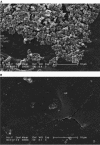Using bacteriophages to reduce formation of catheter-associated biofilms by Staphylococcus epidermidis
- PMID: 16569839
- PMCID: PMC1426991
- DOI: 10.1128/AAC.50.4.1268-1275.2006
Using bacteriophages to reduce formation of catheter-associated biofilms by Staphylococcus epidermidis
Abstract
Use of indwelling catheters is often compromised as a result of biofilm formation. This study investigated if hydrogel-coated catheters pretreated with a coagulase-negative bacteriophage would reduce Staphylococcus epidermidis biofilm formation. Biofilms were developed on hydrogel-coated silicone catheters installed in a modified drip flow reactor. Catheter segments were pretreated with the lytic S. epidermidis bacteriophage 456 by exposing the catheter lumen to a 10-log-PFU/ml culture of the bacteriophage for 1 h at 37 degrees C prior to biofilm formation. The untreated mean biofilm cell count was 7.01+/-0.47 log CFU/cm2 of catheter. Bacteriophage treatment with and without supplemental divalent cations resulted in log-CFU/cm2 reductions of 4.47 (P<0.0001) and 2.34 (P=0.001), respectively. Divalent cation supplementation without bacteriophage treatment provided a 0.67-log-CFU/cm2 reduction (P=0.053). Treatment of hydrogel-coated silicone catheters with an S. epidermidis bacteriophage in an in vitro model system significantly reduced viable biofilm formation by S. epidermidis over a 24-h exposure period, suggesting the potential of bacteriophage for mitigating biofilm formation on indwelling catheters and reducing the incidence of catheter-related infections.
Figures






Similar articles
-
Bacteriophage cocktail for the prevention of biofilm formation by Pseudomonas aeruginosa on catheters in an in vitro model system.Antimicrob Agents Chemother. 2010 Jan;54(1):397-404. doi: 10.1128/AAC.00669-09. Epub 2009 Oct 12. Antimicrob Agents Chemother. 2010. PMID: 19822702 Free PMC article.
-
Bacteriophage-mediated control of a two-species biofilm formed by microorganisms causing catheter-associated urinary tract infections in an in vitro urinary catheter model.Antimicrob Agents Chemother. 2015 Feb;59(2):1127-37. doi: 10.1128/AAC.03786-14. Epub 2014 Dec 8. Antimicrob Agents Chemother. 2015. PMID: 25487795 Free PMC article.
-
Susceptibility of Staphylococcus epidermidis planktonic cells and biofilms to the lytic action of staphylococcus bacteriophage K.Lett Appl Microbiol. 2007 Sep;45(3):313-7. doi: 10.1111/j.1472-765X.2007.02190.x. Lett Appl Microbiol. 2007. PMID: 17718845
-
Catheter lock solutions influence staphylococcal biofilm formation on abiotic surfaces.Nephrol Dial Transplant. 2006 Aug;21(8):2247-55. doi: 10.1093/ndt/gfl170. Epub 2006 Apr 20. Nephrol Dial Transplant. 2006. PMID: 16627606
-
Biofilms in nephrology.Expert Opin Biol Ther. 2008 Aug;8(8):1159-66. doi: 10.1517/14712598.8.8.1159. Expert Opin Biol Ther. 2008. PMID: 18613767 Review.
Cited by
-
Evidence for the presence of Legionella bacteriophages in environmental water samples.Microb Ecol. 2008 Jul;56(1):191-7. doi: 10.1007/s00248-007-9325-z. Epub 2007 Oct 24. Microb Ecol. 2008. PMID: 17957402
-
Propionibacterium (Cutibacterium) acnes Bacteriophage Therapy in Acne: Current Evidence and Future Perspectives.Dermatol Ther (Heidelb). 2019 Mar;9(1):19-31. doi: 10.1007/s13555-018-0275-9. Epub 2018 Dec 11. Dermatol Ther (Heidelb). 2019. PMID: 30539425 Free PMC article. Review.
-
Understanding Biofilms and Novel Approaches to the Diagnosis, Prevention, and Treatment of Medical Device-Associated Infections.Infect Dis Clin North Am. 2018 Dec;32(4):915-929. doi: 10.1016/j.idc.2018.06.009. Epub 2018 Sep 18. Infect Dis Clin North Am. 2018. PMID: 30241715 Free PMC article. Review.
-
Host Defense Peptide-Mimicking Polymers and Polymeric-Brush-Tethered Host Defense Peptides: Recent Developments, Limitations, and Potential Success.Pharmaceutics. 2021 Nov 1;13(11):1820. doi: 10.3390/pharmaceutics13111820. Pharmaceutics. 2021. PMID: 34834239 Free PMC article. Review.
-
Inhibition of biofilm formation by T7 bacteriophages producing quorum-quenching enzymes.Appl Environ Microbiol. 2014 Sep;80(17):5340-8. doi: 10.1128/AEM.01434-14. Epub 2014 Jun 20. Appl Environ Microbiol. 2014. PMID: 24951790 Free PMC article.
References
-
- Adams, M. 1959. Bacteriophages. Interscience Publishers, London, United Kingdom.
-
- Benoit, J. L., G. Carandang, M. Sitrin, and P. M. Arnow. 1995. Intraluminal antibiotic treatment of central venous catheter infections in patients receiving parenteral nutrition at home. Clin. Infect. Dis. 21:1286-1288. - PubMed
-
- Capdevila, J. A., J. Gavalda, and A. Pahissa. 1996. Antibiotic-lock technique: usefulness and controversies. Antimicrobics Infect. Dis. Newsl. 15:9-13.
Publication types
MeSH terms
LinkOut - more resources
Full Text Sources
Other Literature Sources

